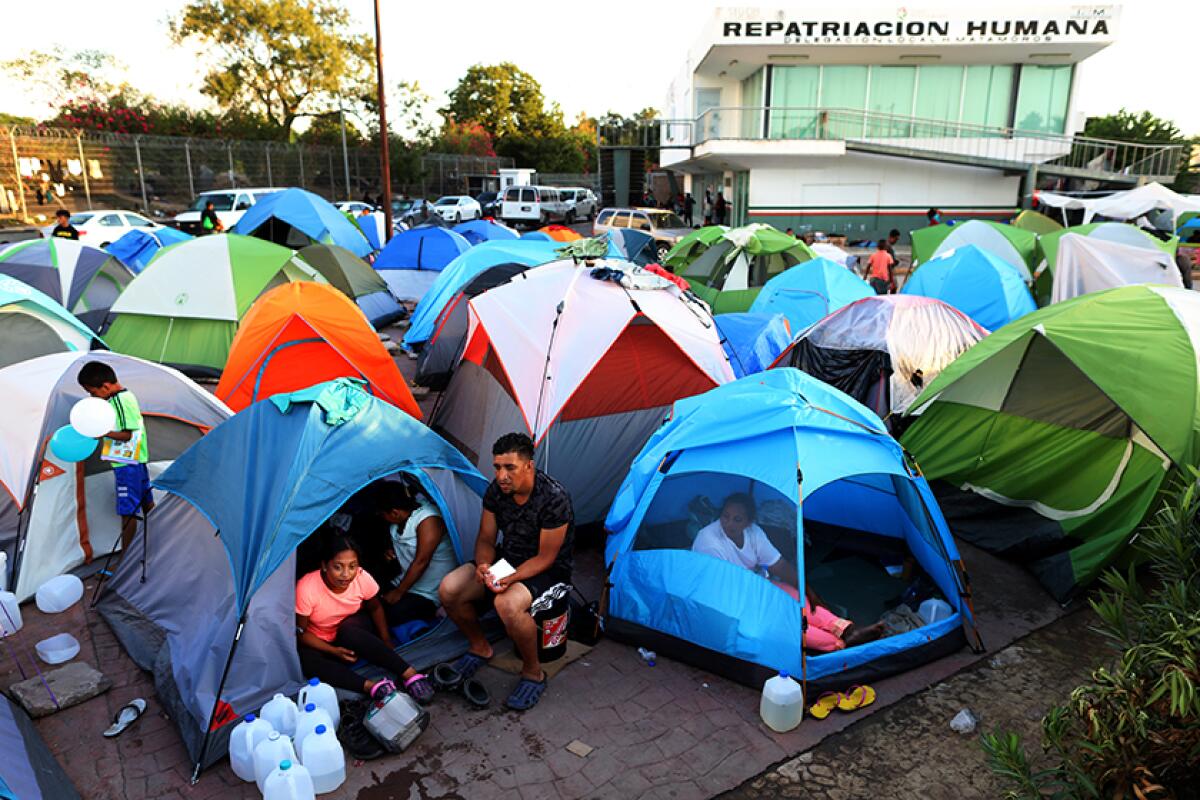Biden has the power to defuse the Central American migrant crisis. He just needs to use it

- Share via
President Biden’s about-face on the number of refugees he will allow to resettle in the U.S. this year is an opportunity for him to also address the seemingly unmanageable border situation and the violence in Central America.
At first, the administration said it would not increase this year’s historically low refugee cap of 15,000, which was established by President Trump. After blowback from refugee rights advocates and Democratic allies, the White House appeared to backtrack. A new cap is expected to be announced by May 15. Previously, Biden had said he wanted to increase it to 62,500 — a number many advocates would like to see.
Here’s where the southern border and Central American opportunities come in.
Let’s begin with the legal distinction between refugees and asylum seekers. The thousands of unaccompanied minors who have captured our attention in recent weeks and other migrants gathered at the border are mostly from Central America, and they are seeking asylum. The minors from Central America will be able to apply for asylum in the United States as will adults who pass “credible fear” interviews.
Refugees are individuals who apply for that status outside the U.S. Generally, refugee applicants are vetted by the United Nations High Commissioner for Refugees, the U.S. State Department and the Department of Homeland Security. Most important, the president sets the ceiling on how many refugees are allowed into the U.S. each year and takes into account humanitarian considerations when designating the countries they can come from.
Aware of the treacherous journey that many of those migrants have taken — and critics who blame the increasing numbers on lax border enforcement — the president is trying to discourage others from coming. He has struck an agreement with Mexico, Guatemala and Honduras to heighten their troop presence along their borders to try to discourage migrants from trying to make their way to the U.S.
But telling migrants not to come because the journey is too dangerous is not going to discourage those who are fleeing extreme gang, cartel and domestic violence. And getting Mexico, Guatemala and Honduras to execute immigration enforcement for us is asking those countries to do our dirty work — and already drawing fire from immigrant and human rights forces.
However, if Biden used his authority to significantly increase the number of refugees allowed into the U.S. from Central America, a more orderly and humane process could be established. It could immediately reduce the number of migrants attempting the dangerous trip and afford them protection from their persecutors.
Wet sweatshirts. Toddler shoes. A line of Scripture. These are some of the things left behind by migrants making their way across the Rio Grande.
Interestingly, the framework for this approach is buried in prospective immigration legislation Biden sent to Congress soon after his inauguration. His proposed U.S. Citizenship Act of 2021 would fund a $4-billion, four-year plan to address the root causes of migration from El Salvador, Guatemala and Honduras, and make it easier for refugees to secure visas to travel to and enter the U.S. — and avoid the dangerous trek to our border. Designated processing centers would be set up in the Central American region to process displaced persons for refugee resettlement.
The wide-ranging legislation, which has been introduced in both houses of Congress, includes a pathway to citizenship for undocumented immigrants and a plan to clear immigration backlogs. However, Republicans have made clear the likelihood of passage is slim.
But here’s the thing about the provisions related to refugee processing: New legislation is not required. The president already has the legal authority to designate how many refugees can come from specific regions of the world, and the U.S. already sets up refugee centers around the globe. In addition, the UNHCR operates in Central America and, of course, the U.S. State Department maintains a presence there via our embassies.
Presidential authority to establish refugee numbers with appropriate consultation with Congress was provided in the Refugee Act of 1980. For geopolitical reasons, U.S. presidents have never allowed meaningful numbers of refugees to come from Central America.
In 1985, during the height of civil wars in Central America, only 3,000 openings in a total allotment of 70,000 refugees were designated for Latin America and the Caribbean; 50,000 were allowed from East Asia.
The pattern continued during President Obama’s last year in office. He established a 2017 refugee quota of 110,000 — but despite serious violence in Central America only 5,000 of those were assigned to Latin America and the Caribbean; 35,000 went to Africa and 40,000 to the Near East/South Asia region.
Trump dropped the refugee quota to 45,000 in October 2017 and decreased the number of Latin American and Caribbean refugees who could be admitted in 2018 to 1,500, although the actual number allowed entry from the region was 955.
Biden already has an excellent and useful tool to help address the southern border situation and the challenge of so many migrants coming here from Central America. He should use it to set a bold annual refugee figure of at least 50,000 for Central America and immediately work with the UNHCR to set up processing centers.
Bill Ong Hing is a professor of law and migration studies at the University of San Francisco and the founder of the Immigrant Legal Resource Center in San Francisco.
More to Read
A cure for the common opinion
Get thought-provoking perspectives with our weekly newsletter.
You may occasionally receive promotional content from the Los Angeles Times.










